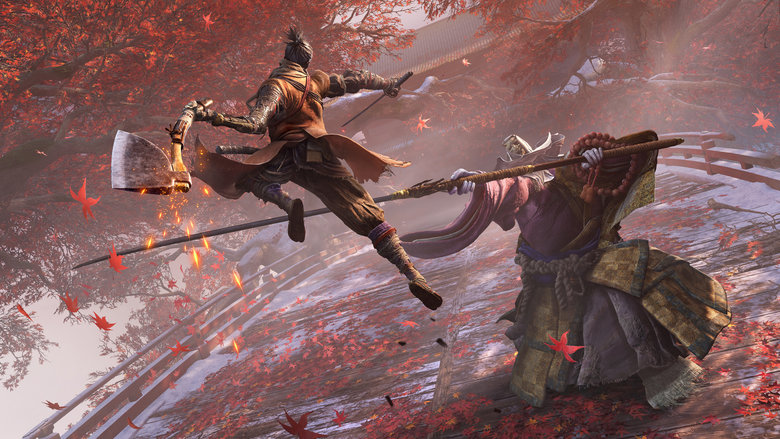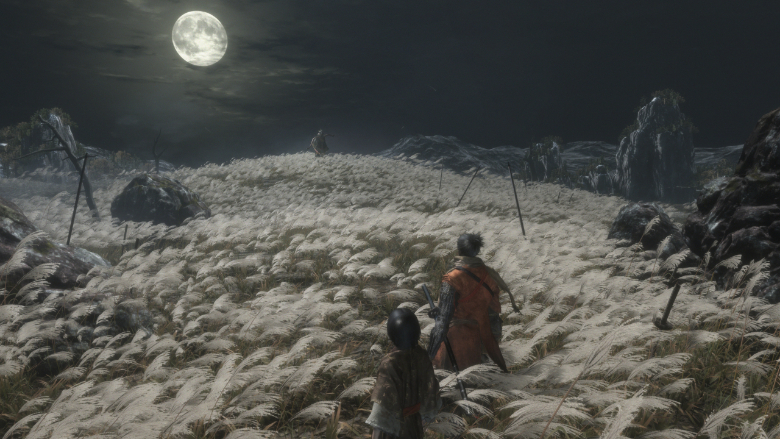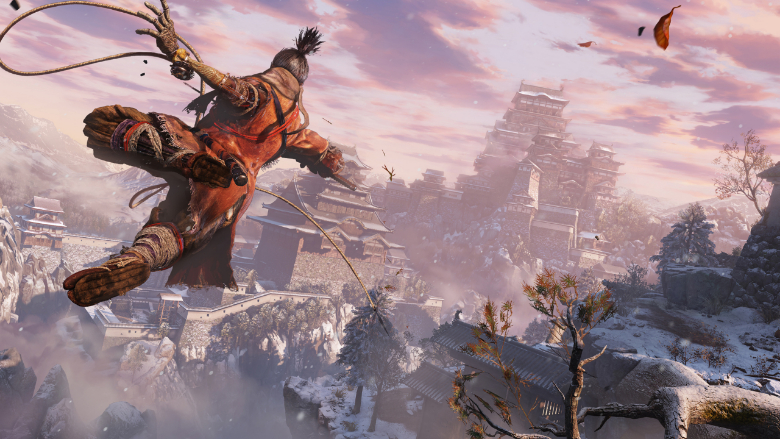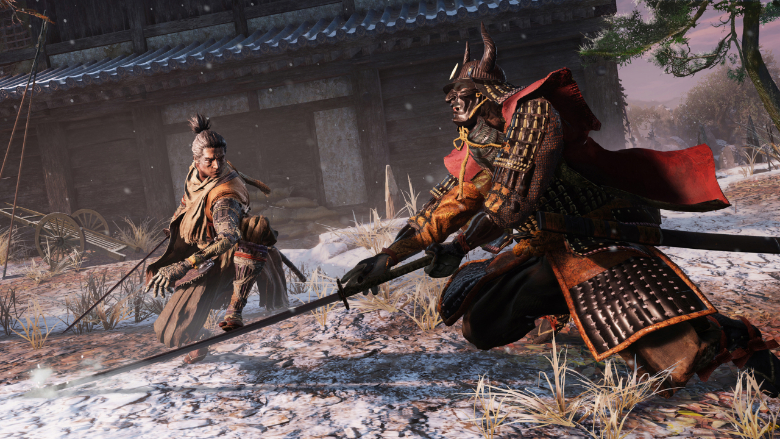
- Game: Sekiro: Shadows Die Twice
- Consoles: Xbox One, PS4, PC (Reviewed)
- Publisher: Activision
- Developer: From Software
- (A review copy of Sekiro: Shadows Die Twice was supplied by the publisher)
Sekiro: Shadows Die Twice made me pound my desk in pure frustration.
I was on my 17th attempt at defeating the deadly illusionist Lady Butterfly, with each fight getting me just a bit closer to delivering the fatal blow. Unlike the scrappy fights of Bloodborne, Sekiro’s fights are methodical and precise. My battle with Lady Butterfly forced me to not only memorize her every move but recognize what attacks on my side would be effective. I had to adapt or accept that she will always vanquish me. It was an unnatural feeling at first, but one I quickly grew past during my time with Sekiro.
Finally, after what felt like a hundred tries, I was able to put this boss down for good. It was an exceptionally difficult battle, but conquering this foe caused a wave of pure bliss to wash over me. This is the world of developer From Software’s latest game, Sekiro: Shadows Die Twice.
Set in 16th century Japan, you assume the role of a shinobi who is tasked with protecting his young lord known as the Divine Hier. After losing your arm in a duel, you’re left for dead and the lord is kidnapped. Awakening in a mysterious temple with a new prosthetic arm and the ability to come back to life, you set out on a long journey for revenge.
Despite the heavier focus on characters, the From Software faithful will quickly feel at home thanks to Sekiro’s cryptic storytelling. While this certainly lends a lot of mystery to this fantastical vision of 16th century Japan, it ends up hindering certain aspects of the plot. Most of the lore is hidden behind hidden messages, item descriptions, and optional in-game dialogue. This is great for fleshing out the world, but there’s not enough meat on the bone.

Your character’s driving force is to rescue the Divine Hier, but Sekiro spends a comically short amount of time building up their relationship. You don’t feel connected or responsible for him at all. He’s simply a reason for you to go from place to place killing almost everything you come across. It’s a fine backdrop, but with From Software’s noticeable push to try and deliver a more concise story, it ends up floundering due to their own design choices.
Thankfully, the superb gameplay, level design, and mechanics make up for any cracks in the story. Unlike other From Software games, your shinobi is only able to wield his katana in combat. There’s no magic, bows, or additional blades that can be swapped out and the katana itself is never upgraded. Users can unlock different skills and techniques as they progress, allowing them a wider variety of moves.
While you start out with only a few combos, once you reach the end there will be all manner of different techniques you can perform. These aren’t just for show, as every skill you unlock has a practical application. The Miriki Counter allows players to stop thrusting attacks, while a special Ninjutsu ability lets you vanish in a cloud of red smoke after a successful stealth kill. All of these give an incredible sense of progression along your 30+ hour journey.
Your only additional tool is a prosthetic arm that’s part grappling hook, gadget dispenser, and weapon. There are a plethora of different items that can be used with your prosthetic and understanding what they counter is critical to your success. Weapons such as Loaded Axe, allows your shinobi to break enemy shields while the firecrackers scare beasts.

Players can also upgrade their various gadgets with stronger variations or special moves that tie them into combos. Resources are scarce so expect to make tough choices as you progress through Sekiro: Shadows Die Twice the first time. However, you’ll need to actually find these modified weapons first, as they’re scattered all throughout the world. Sekiro gives you very little direction, so expect to spend a lot of time scouring the world for tucked away goodies.
The last tool in your arsenal is death itself, as your Shinobi can come back from the grave once per rest. Coming back to life is more than just hitting a Continue button when you make a mistake. If you perish on your second life then you’ll not only lose vital experience and money, but a mysterious disease will spread to the NPCs. This lends real weight to the idea of getting a second chance, as sometimes it’s better to just die. Understanding when and how to use your resurrection ability is one of the most important mechanics in Sekiro.
Tying this all together is a superb combat system that forces players to constantly change up their playstyle. Every enemy – including your shinobi – boasts both a Posture and health bar. The former focuses on a specific character’s resolve during a battle. A Posture meter will increase when they are forced to block, get countered, or struck with a certain gadget. Filling this meter up allows the user to perform a Shinobi Death Blow, which instantly kills most lower tier enemies.

However, some foes boast multiple death blow counters, requiring players to strike them down multiple times. Every enemy is different and sometimes attacking their health bar directly is a much better option. Sekiro won’t explain how to combat each foe, so it’s up to you to learn their moves, tells, and weakness. This turns battles into elaborate dances of death, with both sides prodding at each other’s defenses. It’s remarkably complex for how simple the general moment to moment gameplay can be.
Bosses are Sekiro’s ultimate challenge and there’s quite a few of them peppered throughout the world. Despite only a few getting personal, intro cutscene others act as skill checks to test the player’s knowledge. Killing them rewards rare resources that are used to upgrade your health and gadgets. Sekiro’s bosses never feel unfair, as the game consistently leaves just enough openings for players to capitalize on their foe’s weakness. This balance between delivering powerful bosses while simultaneously giving them an exploitable weakness is delicate, but From Software walks the line masterfully.
Some of these bosses can even take heavy damage via a stealth death blow, which rewards those for taking a sneaky approach. New to From Software’s games, sneaking around and methodically taking out key targets is a real strategy. There are multiple locations where stealth is objectively the best option, but like everything else, it’s on the player to figure this out.
Clearing an entire camp of enemies is incredibly satisfying, however, the A.I. can be pretty dumb at times. You can easily trigger the alarm, go hide on a roof, and wait for them to forget about you. In a game all about high-stakes, messing up a stealth section is shockingly forgiving.
Sekiro: Shadows Die Twice Takeaways

Sekiro: Shadows Die Twice boasts the best combat in all of From Software’s library. Locking swords with an opposing warrior is a thrilling experience that very few games can deliver. Despite the steep learning curve, Sekiro is never unfair and there’s always a lesson to learn in defeat. The greater focus on dynamic, nuanced fights greatly improves over Dark Souls’ hack and slash methodology.
While the story could have used a bit more focus and build up, Sekiro’s hauntingly beautiful world will instantly pull you in. This is more than just “Dark Souls in Japan,” but a captivating, cold, and satisfying experience. Sekiro: Shadows Die Twice easily cements itself as one of the best modern action/adventure games of the generation.
